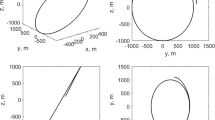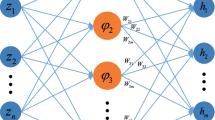Abstract
With the recent flurry of the research on Inner-Formation satellite system, there has been apparent need for a set of linearized equations to describe the relative motion of satellites under the effect of the J 2 geopotential disturbance, which is the important perturbed-factor for low-orbit Inner-Formation system. Hence, on the assumption of small eccentricity, a new set of linearized equations of motion is proposed that accounts for J 2 perturbations in an elliptical orbit. To avoid the collision between the inner satellite and the outer satellite, the Minimum Sliding Mode Error Feedback Control (MSMEFC) is developed to perform a real-time control on the outer satellite with the uncertain perturbations from the space. The highlight of MSMEFC is to introduce the concept of equivalent control error, which is the key utilization of MSMEFC. It is shown that the proposed MSMEFC can compensate any kinds of uncertain perturbations. Besides, in this paper, the relationship between the equivalent control error and uncertain perturbations is discussed. The robustness and steady-state error of MSMEFC are also analyzed to show its theoretical advantages compared with traditional SMC. Numerical simulations are employed to check the fidelity of the linearized equations. In addition, the efficacy of MSMEFC is verified by the utilization of Inner-Formation system with high control precision.
Similar content being viewed by others
References
Neeck S P, Magner T J, Paules G E. NASA’s small satellite missions for earth observation. Acta Astronaut, 2005, 56: 187–192
Folta D, Bristow J, Hawkins A, et al. NASA’s autonomous formation flying technology demonstration, earth observing- 1. In: Proceedings of the 1st International Symposium on Formation Flying Missions and Technologies, Toulouse, 2002
Cabeza I, Maetinez A. Smart-2: an ESA mission to demonstrate the Key technologies for formation flying and dragfree control. In: Proceedings of the 1st International Symposium on Formation Flying Missions and Technologies, Toulouse, 2002
Kristiansen R, Nicklasson P J. Spacecraft formation flying: a review and new results on state feedback control. Acta Astronaut, 2009, 65: 1537–1552
Bauer F, Bristow J, Carpenter J, et al. Enabling spacecraft formation flying in any earth orbit through spaceborne GPS and enhanced autonomy technologies. Space Technol, 2001, 20: 175–185
Wang Z K, Zhang Y L. A novel concept of satellite gravity field measurement system using precision formation flying technology. In: Proceedings of the 3rd CSA-IAA Conference on Advanced Space Systems and Applications-Satellite Applications and Applied Satellites, Shanghai, 2008. 1235–1240
Wang Z K, Zhang Y L. Acquirement of pure gravity orbit using precision formation flying technology. In: Proceedings of the 6th Internet Workshop on Satellite Constellation and Formation Flying, Taipei, 2010. 1135–1140
Dang Z H, Zhang Y L. Formation control using µ-synthesis for inner-formation gravity measurement satellite system. Adv Space Res, 2012, 49: 1487–1505
Seeber G. Satellite Geodesy. 2nd completely revised and extended edition. Berlin/New York: Walter de Gruyter, 2003
Hill G. Researches in the lunar theory. Amer J Math, 1878, 1: 5–26
Clohessy W H, Wiltshire R S. Terminal guidance system for satellite rendezvous. J Aerosp Sci, 1960, 27: 653–658
Kechichian J A. Motion in general elliptic orbit with respect to a dragging and processing coordinate frame. J Astronaut Sci, 1998, 46: 25–45
Sedwick R J, Miller D W, Kong E M C. Mitigation of differential perturbations in clusters of formation flying satellites. AAS/AIAA Space Flight Mechanics Meeting, 1999. AAS Paper: 99–124
Alfriend K, Schaub H, Gim D. Gravitational perturbations, nonlinearity and circular orbit assumption effects on formation flying control strategies. Rocky Mountain Conference, 2000. AAS Paper: 00–12
Gim D, Alfriend K. The state transition matrix of relative motion for the perturbed non-circular reference orbit. AAS/AIAA Space Flight Mechanics Meeting, 2001. AAS Paper: 01–222
Schaub H, Alfriend K T. J2 invariant relative orbits for formation flying. Celest Mech Dynam Astron, 2001, 79: 77–95
Schweighart S A, Sedwick R J. High fidelity linearized J2 model for satellite formation flight. J Guid Control Dynam, 2002, 25: 1073–1080
Utkin V I. Variable structure system with sliding modes. IEEE Trans Automat Contr, 1977, 22: 212–222
Cao L, Chen X Q, Misra A K. Minimum sliding mode error feedback control for fault tolerant reconfigurable satellite formations with J2 perturbations. Acta Astronaut, 2014, 96: 201–216
Massey T, Shtessel Y. Continuous traditional and high-order sliding modes for satellite formation on control. J Guid Control Dynam, 2005, 28: 826–831
Cao L, Chen X Q, Sheng T. Fault tolerant small satellite attitude control using adaptive non-singular terminal sliding mode. Adv Space Res, 2013, 51: 2374–2393
Schaub H, Junkins L. Analytical Mechanics of Space Systems. Reston: American Institute of Aeronautics and Astronautics, 2003
Francis B. Satellite formation maintenance using differential atmospheric drag. Thesis. McGill University, Montreal. 2011
Sabatini M, Palmerini G B. Linearized formation-flying dynamics in a perturbed orbital environment. In: 2008 IEEE Aerospace Conference, Big Sky, 2008. 1310–1321
Godard Kumar K D. Fault tolerant reconfigurable satellite formations using adaptive variable structure techniques. J Guid Control Dynam, 2010, 33: 969–984
Author information
Authors and Affiliations
Corresponding author
Rights and permissions
About this article
Cite this article
Cao, L., Chen, X. Minimum sliding mode error feedback control for inner-formation satellite system with J 2 and small eccentricity. Sci. China Inf. Sci. 59, 072203 (2016). https://doi.org/10.1007/s11432-016-5573-1
Received:
Accepted:
Published:
DOI: https://doi.org/10.1007/s11432-016-5573-1




